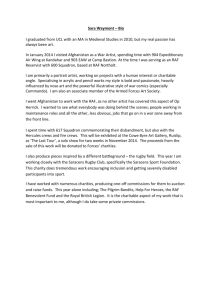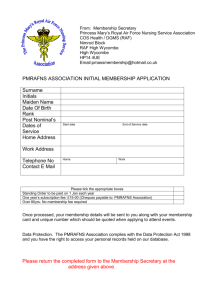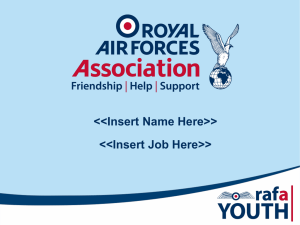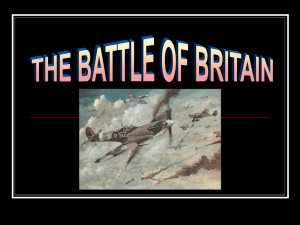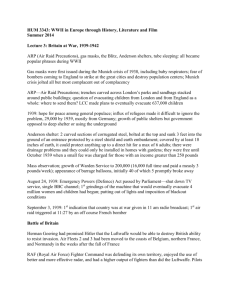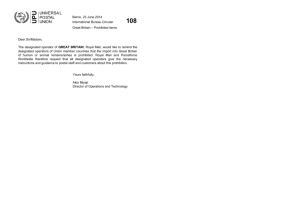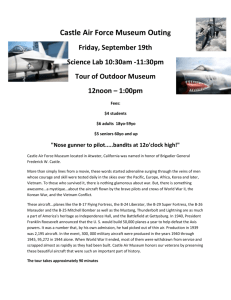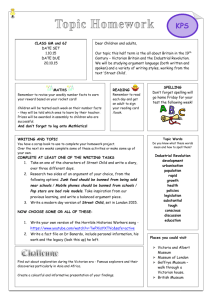English Level 2 Reading
advertisement
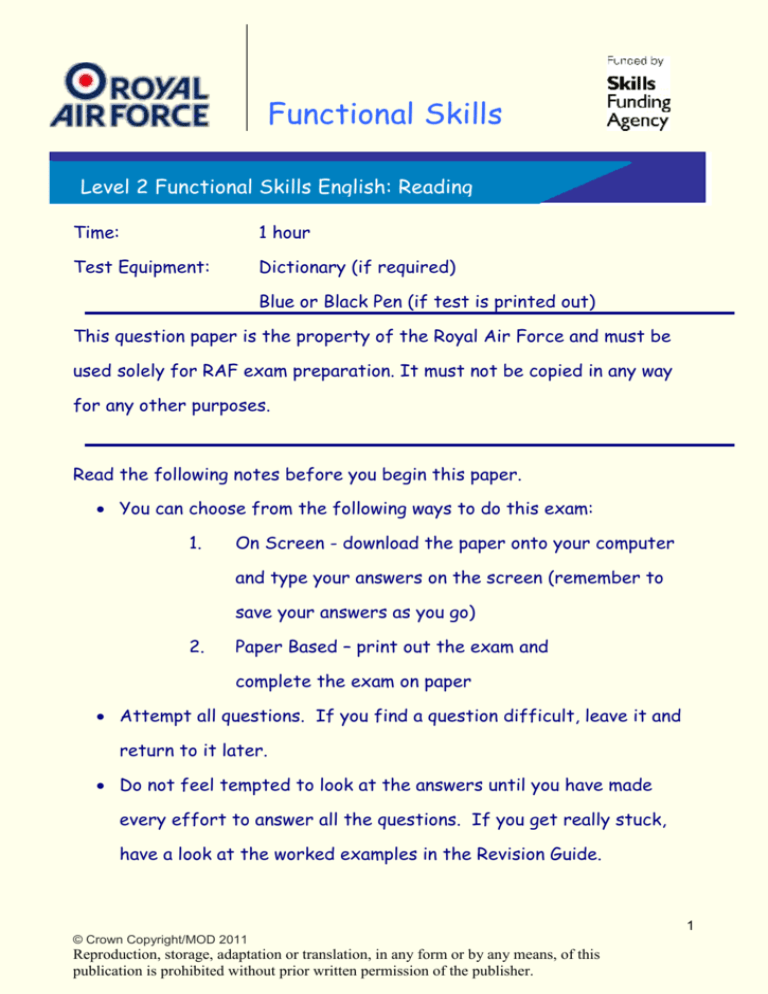
Functional Skills Level 2 Functional Skills English: Reading Time: 1 hour Test Equipment: Dictionary (if required) Test Blue or Black Pen (if test is printed out) This question paper is the property of the Royal Air Force and must be used solely for RAF exam preparation. It must not be copied in any way for any other purposes. Read the following notes before you begin this paper. You can choose from the following ways to do this exam: 1. On Screen - download the paper onto your computer and type your answers on the screen (remember to save your answers as you go) 2. Paper Based – print out the exam and complete the exam on paper Attempt all questions. If you find a question difficult, leave it and return to it later. Do not feel tempted to look at the answers until you have made every effort to answer all the questions. If you get really stuck, have a look at the worked examples in the Revision Guide. 1 © Crown Copyright/MOD 2011 Reproduction, storage, adaptation or translation, in any form or by any means, of this publication is prohibited without prior written permission of the publisher. Task You are a member of an employment committee which promotes a range of different careers for young people within the local community. The theme for the next committee meeting is careers in the RAF. A few members of the committee, including you, have suggested organising a trip to the RAF Museum London for all those who are considering joining the military. The trip in question is to be discussed at the next committee meeting. Your job is to conduct some research on the RAF Museum London and to make notes in favour of the trip which will be presented at the committee meeting. Additionally, you have been asked to make some preliminary notes on how to structure a publicity campaign in order to promote the event to the young people in the community. During the research process you find the following documentation and decide that it will be useful for your task. Read Documents 1, 2, 3, and 4 and answer the following questions. 2 © Crown Copyright/MOD 2011 Reproduction, storage, adaptation or translation, in any form or by any means, of this publication is prohibited without prior written permission of the publisher. Document 1 The Royal Air Force Museum's Battle of Britain Hall tells the story of the world's first decisive air battle - when the Royal Air Force stood alone against the might of the German Luftwaffe during World War Two. Recently refurbished to commemorate the 70th anniversary of the Battle of Britain, this aircraft collection contains the most comprehensive selection of aircraft from both sides that fought in the Battle of Britain. Alongside the very planes that fought for supremacy over the Channel, interactive displays give you an insight into the minds and actions of those who experienced the Battle at first hand. After war broke out in 1939, large numbers of Allied troops in France prepared for the German onslaught. When it came in May 1940, German tactics surprised and overwhelmed Allied air and ground forces, who retreated from Dunkirk. This left Britain isolated from Europe - the enemy just 20 miles away across the English Channel. With around four times more aircraft than RAF Fighter Command, Germany got ready to invade England. 2010 marks the 70th anniversary of the Battle of Britain. If you would like to view in person aircraft that fought in the Battle of Britain, why not visit us? New features of the Hall’s recent refurbishment include: Unseen footage from the 1968 film ‘The Battle of Britain’ 3 © Crown Copyright/MOD 2011 Reproduction, storage, adaptation or translation, in any form or by any means, of this publication is prohibited without prior written permission of the publisher. New panels giving added insight into history, key personalities and Battle of Britain operations A 5m high statue honouring Sir Keith Park whose command of Royal Air Force 11 Group Fighter Command was integral to RAF’s success in the Battle Our Finest Hour, the Museum’s sound and light show, which explains the Battle From 13th May 2010 a permanent exhibition ‘Art of the Battle of Britain’, located on the Hall’s Mezzanine Level The Battle of Britain Hall at RAF Museum London is open daily from 12 noon to 6pm. 4 © Crown Copyright/MOD 2011 Reproduction, storage, adaptation or translation, in any form or by any means, of this publication is prohibited without prior written permission of the publisher. Document 2 Fine Art Collection The RAF Museum Fine Art Collection is, arguably, the best collection of military aviation artwork in the United Kingdom representing the people, aircraft, equipment and 'Service Life' of the Royal Air Force and its predecessors, the Royal Flying Corps and the Royal Naval Air Service. The collection currently holds more than 6,500 works in the form of paintings, drawings, posters and other printed material. There is also a small sculpture collection. Period The collection is particularly strong from 1920 to about 1955, though there is much First World War material, some 19th century ballooning material and a selection of post 1945 pictures. The Museum is fortunate in holding the majority of the works selected for the RAF by the War Artists Advisory Committee covering the Second World War. Major Holdings There are large holdings of portraits by Eric Kennington, Captain Cuthbert Orde, Elva Blacker and Sir William Rothenstein. Printed Items Printed items include recruitment, air display and airline advertisement posters as well as 'fine art' posters intended for domestic use. Cartoons and caricatures are represented by Bill Hooper of 'Pilot Officer Prune' fame and Fred May. 5 © Crown Copyright/MOD 2011 Reproduction, storage, adaptation or translation, in any form or by any means, of this publication is prohibited without prior written permission of the publisher. Document 3 Medals & Uniform Collections These collections have been built up since the early 1960s and contain gems from the Royal Engineers Balloon sections of the late 1890s onwards. The uniform collection is particularly strong on the First and Second World Wars and contains good coverage of other periods up to the 1970s. It is remotely housed and is not immediately accessible at London. The Medal collection is securely stored at London where material can be made available to researchers by appointment. Its coverage is good up to the 1960s. Medal Collection The medal collection encompasses all orders, decorations and medals including the clothing and insignia of the Orders of Chivalry. It does not include sports medals or other commemorative medallions. Uniform Collection The Uniform Collection contains all clothing - uniform, working and flying clothing including life jackets, and worn personal equipment - webbing ammunition carriers, belts and packs. It also contains uniform accessories such as walking sticks and ceremonial swords. 6 © Crown Copyright/MOD 2011 Reproduction, storage, adaptation or translation, in any form or by any means, of this publication is prohibited without prior written permission of the publisher. Document 4 Aircraft Information Aircraft Serial Number: ML824 Historical Period: World War Two RAF Museum Collection Ref: 71/A/1408 Location at RAF Museum: RAF Museum London, Battle of Britain Hall Aircraft History By the start of World War Two in September 1939 three squadrons had been equipped with the Sunderlands. Seven hundred and forty-nine Sunderlands were built, and they served throughout the war. The final Coastal Command Sunderland operational mission was in June 1945 over four weeks after the German surrender. Long-range Sunderland operations also took place overseas from bases in Africa and the Far East. Post-war the type took part in the Berlin Airlift carrying 4920 tonnes (4847 tons) of freight. During the Korean War Sunderlands based in Japan undertook nearly 900 operational sorties totally over 13350 hours of flying. The Sunderland finally retired from RAF service in 1959 when the last aircraft were scrapped at RAF Seletar, Singapore. The Sunderland's design was so good that it remained in front line service for over twenty years. It was also the last flying-boat operated by the Royal Air Force. The Sunderland was produced as a military development of the 'C'-Class Empire flying-boat operated by Imperial Airways. It entered service in June 1938 and was the first British flying boat to have power-operated gun turrets as part of its defensive armament. This strong protective armament resulted in the Germans giving it the nickname 'Flying Porcupine'. 7 © Crown Copyright/MOD 2011 Reproduction, storage, adaptation or translation, in any form or by any means, of this publication is prohibited without prior written permission of the publisher. Activity 1a. Comment on how the writer of Document 1 uses language to try to influence the reader. …………………………………………………………………………………………………………………………………………………………… …………………………………………………………………………………………………………………………………………………………… ……………………………………………………………………………………………………………………………………………(1 mark) 1b. Give one example from Document 1 of how language is used in this way. …………………………………………………………………………………………………………………………………………………………… …………………………………………………………………………………………………………………………………………………………… ……………………………………………………………………………………………………………………………………………(1 mark) 2a. Document 2 would be most useful to the committee if they were: A. interested in the Orders of Chivalry B. attempting to obtain an in depth account of the ‘Flying Porcupine’ C. researching into the works of Elva Blacker D. identifying the new features of the Battle of Britain Hall. …………………………………………………………………………………………………………………………………………………………… ……………………………………………………………………………………………………………………………………………..(1 mark) 3a. What medals are not included in the medal collection? …………………………………………………………………………………………………………………………………………………………… ……………………………………………………………………………………………………………………………………………..(1 mark) 4a. Name the agency which is responsible for covering the art work from the Second World War. …………………………………………………………………………………………………………………………………………………………… …………………………………………………………………………………………………………………………………………… (1 mark) 4b. What was the real name of ‘Pilot Officer Prune’ and what type of art work was he responsible for? …………………………………………………………………………………………………………………………………………………………… …………………………………………………………………………………………………………………………………………………………… …………………………………………………………………………………………………………………………………………(3 marks) 8 © Crown Copyright/MOD 2011 Reproduction, storage, adaptation or translation, in any form or by any means, of this publication is prohibited without prior written permission of the publisher. 5a. Name the main defensive attributes of the Sunderland aircraft. …………………………………………………………………………………………………………………………………………………………… ……………………………………………………………………………………………………………………………………………(1 mark) 6a. In your own words, describe what happened between 1939 and 1940 drawing on the information in Document 1. …………………………………………………………………………………………………………………………………………………………… …………………………………………………………………………………………………………………………………………………………… …………………………………………………………………………………………………………………………………………………………… …………………………………………………………………………………………………………………………………………………………… …………………………………………………………………………………………………………………………………………..(5 marks) 7a. What are the 2 major events mentioned in the Sunderland’s post-war activity? …………………………………………………………………………………………………………………………………………………………… …………………………………………………………………………………………………………………………………………………………… …………………………………………………………………………………………………………………………………………..(2 marks) 7b. Give a description of the service that the Sunderland aircraft provided at each event. …………………………………………………………………………………………………………………………………………………………… …………………………………………………………………………………………………………………………………………………………… …………………………………………………………………………………………………………………………………………………………… …………………………………………………………………………………………………………………………………………..(3 marks) 7c. What style of writing best describes Document 4? A. A piece of persuasive writing B. An informative piece of writing C. A piece of prose D. A series of facts E. A piece of iambic pentameter …………………………………………………………………………………………………………………………………………………………… ………………………………………………………………………………………………………………………………………….....(1 mark) 8a. Whose command was integral to the RAF’s success in the Battle of Britain? …………………………………………………………………………………………………………………………………………………………… ……………………………………………………………………………………………………………………………………………..(1 mark) 9 © Crown Copyright/MOD 2011 Reproduction, storage, adaptation or translation, in any form or by any means, of this publication is prohibited without prior written permission of the publisher. 9a. According to Document 2 what does the RAF Museum Fine Art Collection represent? …………………………………………………………………………………………………………………………………………………………… …………………………………………………………………………………………………………………………………………………………… …………………………………………………………………………………………………………………………………………………………… …………………………………………………………………………………………………………………………………………..(3 marks) 9b. How many works does the collection hold? ……………………………………………………………………………………………………………………………………………..(1 mark) 9c. What time periods are mentioned in Document 2 and for what reason? …………………………………………………………………………………………………………………………………………………………… …………………………………………………………………………………………………………………………………………………………… …………………………………………………………………………………………………………………………………………………………… …………………………………………………………………………………………………………………………………………………………… …………………………………………………………………………………………………………………………………………………………… …………………………………………………………………………………………………………………………………………..(5 marks) 10a. What would prove problematic if you wanted to view the entire Uniform Collection at RAF Museum London? ……………………………………………………………………………………………………………………………………………................. .................................................................................................................................................(2 mark) Total Marks: 32 10 © Crown Copyright/MOD 2011 Reproduction, storage, adaptation or translation, in any form or by any means, of this publication is prohibited without prior written permission of the publisher. End of Assessment 11 © Crown Copyright/MOD 2011 Reproduction, storage, adaptation or translation, in any form or by any means, of this publication is prohibited without prior written permission of the publisher.
